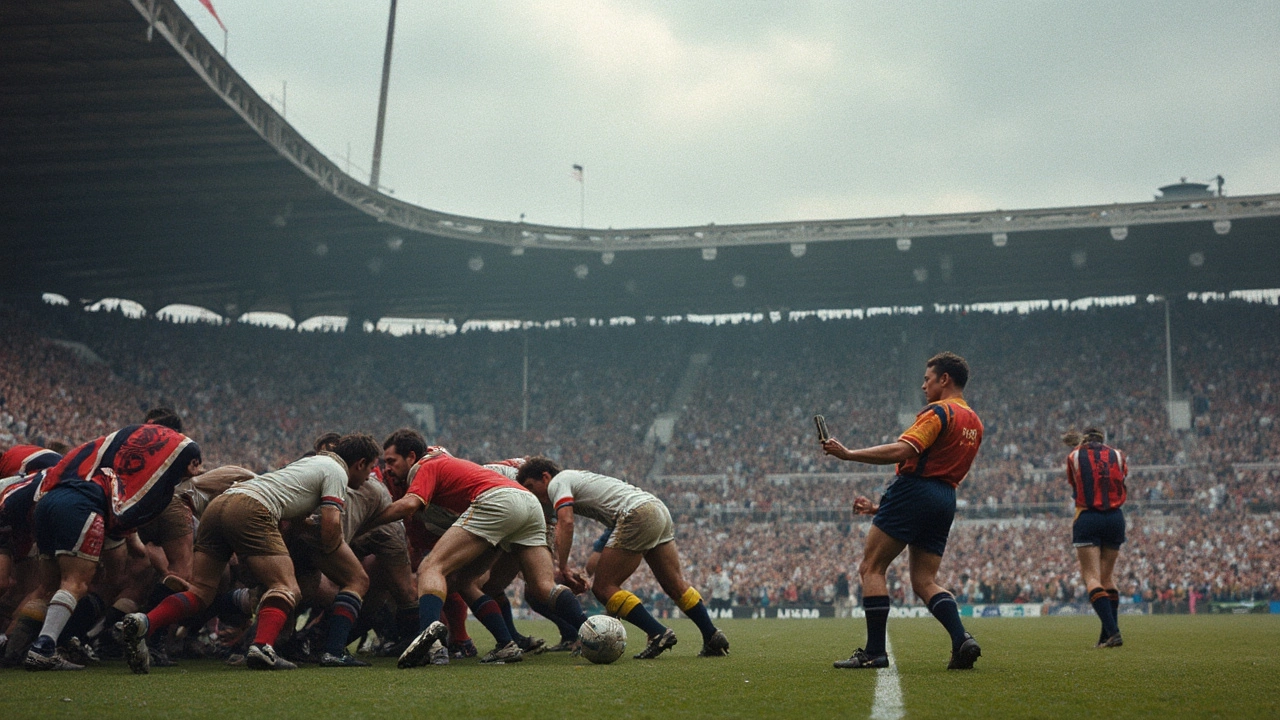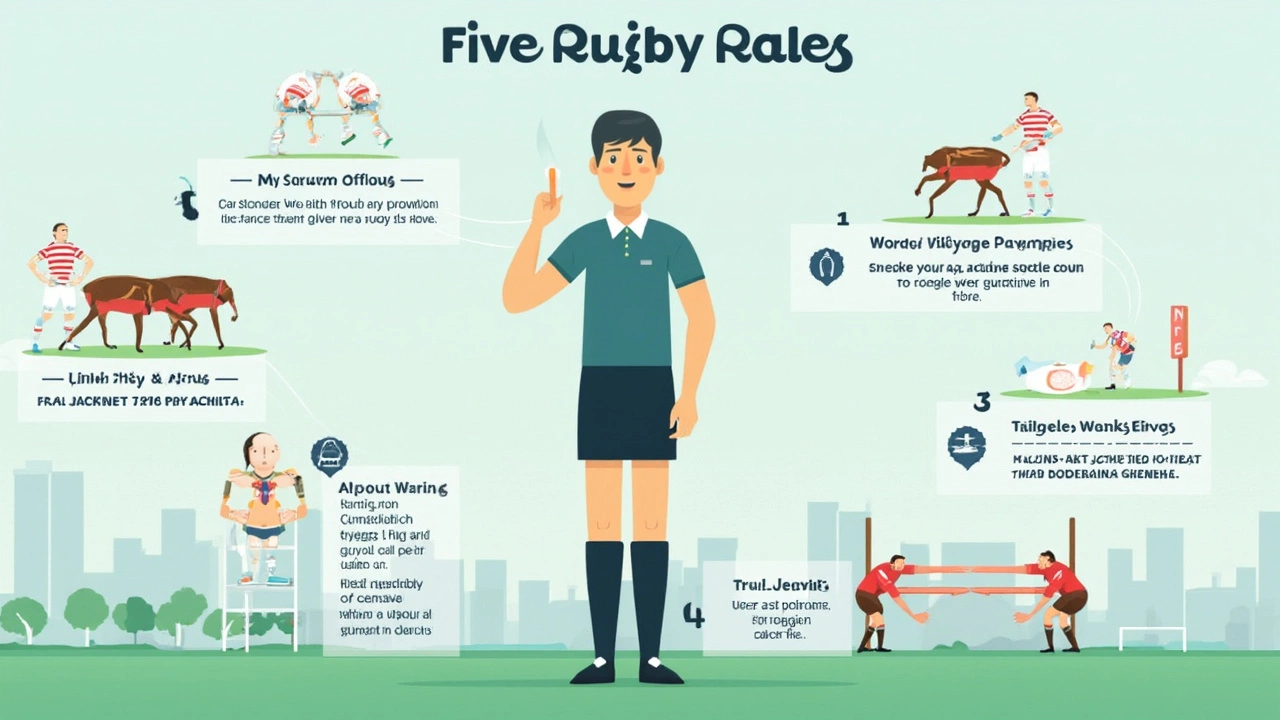
Rugby Fixtures May 7, 2025
Rugby Rules: The Five Basics Every Fan Should Know
Ever watched a rugby match and wondered why things suddenly stop and the crowd goes wild or groans? It almost always ties back to the five core rules. Even if you’ve never picked up a ball, these rules unlock everything happening on the field.
If you’re tracking fixtures or just trying to keep up with conversation down at the pub, understanding what’s okay—and what’ll have the referee blowing up the play—is key. Following these rules isn’t just about avoiding penalties, it’s how teams control the game, break through defenses, and set up points. Ready for fewer head-scratching moments and more ‘aha’ when players celebrate a turnover or try?
Let’s break down exactly what makes rugby tick—without jargon or long-winded lectures. This isn’t just for the new fans either; even old hands can miss the subtle details of these five core rules.
- The Offside Rule Explained
- Tackling: What’s Legal and What’s Not
- Forward Passes and Knock-Ons
- Scoring: How Points Add Up
- The Breakdown and Rucks
The Offside Rule Explained
The rugby offside rule is one of the biggest things that keeps the game moving and fair. If you’re offside, you’re basically in a spot you’re not allowed to be, and you can cause a penalty. Sounds tough? It’s actually straightforward when you know where to look.
In rugby, a player is considered offside if they’re closer to the opponent’s goal line than both the ball and the teammate last handling it. Think of it like this: you can’t hang out ahead of the play and wait for a pass—no cherry picking like in basketball. This keeps things honest and lets defense have a fair shot at stopping the attack.
There’s a bit more to it when it comes to different parts of the game, like open play, rucks, and set pieces. Here’s where being offside gets called most often:
- General Play: You must be behind the ball. If you’re ahead, don’t interfere unless you get put back onside by an action like a kick or a teammate running past you.
- At the Ruck or Maul: Your offside line is the hindmost foot (the foot closest to your own try line) of your teammate who is part of the ruck or maul. Step over it before the ball comes out, and it’s a penalty.
- Set Pieces (like scrums and lineouts): There are set distances you have to respect. For scrums, stay behind the last foot of your scrum; for lineouts, there’s a two-meter space you can’t cross.
Referees are trained to keep a close eye on this, and in the rugby fixtures at professional level, you’ll see linesmen (touch judges) pointing out offside spots all the time. In the 2023 Rugby World Cup, average games saw nearly 6 offside penalties. Teams who kept their shape and stayed onside rarely handed over free kicks and ended up winning most of their matches.
| Offside Violations (RWC 2023) | Average per Game |
|---|---|
| General Play | 3.5 |
| Ruck/Maul | 2.2 |
Quick tip: If you ever end up playing or watching live, keep an eye on the referee’s arm—straight out usually means someone just got caught offside. Get this one right and you’ll sound like you’ve followed rugby rules all your life.
Tackling: What’s Legal and What’s Not
If you only remember one thing about rugby rules, let it be this: not every tackle is okay, and the refs don’t cut you any slack. Tackling rules keep games tough but safe, and players know that pushing those limits is how yellow and red cards are handed out.
So, what counts as a legal tackle? You have to wrap your arms around the ball carrier, and you need to bring them down below their shoulders. Anything higher—even by accident—is called a high tackle, and it’s a fast way to get penalized. No one wants to see a swinging arm near someone’s head.
- Only the ball carrier can be tackled. If you hit someone who doesn’t have the ball, that’s a penalty every time.
- No tackles from behind and above the shoulders. A high tackle gets whistled right away and usually comes with a warning or card.
- No lifting and dropping a player to make a ‘dump’ tackle. If a tackled player lands on their head or neck, the punishment gets even harsher.
- Always use your arms. Shoulder-charging into a player without wrapping your arms equals an automatic penalty.
Want some real numbers? World Rugby’s mid-2024 safety report showed that 65% of in-game penalties in pro matches come from players messing up the tackle—either going too high, using the shoulder, or not letting go after the tackle. That makes it the rule most players break, often when the game gets intense.
One more thing that catches new fans: once you’ve tackled someone and they’re on the ground, you have to release them and let go of the ball fast. Hanging on is called ‘not releasing,’ and it hands the other team a shot at goal or a quick tap penalty.
If you’re learning about rugby basics or want to avoid confusion when watching rugby fixtures, keep your eyes on the tackle—it decides games more often than any fancy pass or kick.

Forward Passes and Knock-Ons
This is the bit that catches loads of new rugby rules fans out, because it’s totally different from sports like American football. In rugby, you just can’t throw or even accidentally pass the ball forward with your hands. That’s called a forward pass, and it’s one of the simplest ways to lose possession. Doesn’t matter if you’re desperate, under pressure, or planning some mad offload—if your hands propel the ball toward the other team’s goal line, the ref will stop play right away.
The trick here is the ball can only travel forward if it’s kicked, not passed. So all passes by hand have to go sideways or backwards. This isn’t just a picky tradition. It’s what makes rugby’s attacking plays so creative—those fast, flat passes that swing wide, or quick little offloads during a tackle. But yeah, sometimes the pass looks like it went forward, but if your hand motion was backward and the ball drifted forward because of wind or your speed, it’s usually okay. Refs check the hands, not where the ball ends up.
Then you’ve got knock-ons. Bit confusing at first, but really simple. If a player fumbles or drops the ball—and it bounces or rolls forward (toward the opponent’s try line)—it’s a knock-on. Play stops and your team loses the ball. You can juggle, mishandle, or rebound that ball as long as it doesn’t touch the ground or another player’s hand and go forward. If it just drops straight down or bounces back toward your own end, that’s fine—play on!
- If you deliberately knock the ball forward with your hand or arm—it’s a penalty and sometimes even a yellow card if it kills a scoring chance.
- Kicking ahead is totally legal—offloads with your foot are a standard attacking option.
- Accidental knock-ons happen often in rainy games, but you’ll see some pros who almost never fumble. That takes serious skill.
| Cause | Percent of Stoppages |
|---|---|
| Knock-on | 29% |
| Forward Pass | 17% |
| Penalties | 32% |
| Other | 22% |
Best tip? When you’re watching, look at the passer’s hands, not just the ball’s direction. It’ll make reading fixtures way less confusing—especially if you’re trying to explain to someone why play just stopped out of nowhere. And if you’re playing, keep your passes low, flat, and always aim backwards.
Scoring: How Points Add Up
Rugby scoring is simple when you break it down, and knowing the basics helps you keep track of who’s really winning during those tense moments in any rugby fixtures. All points aren’t created equal—each way of scoring gives teams a different amount of points, so every decision on the field counts.
Here’s the breakdown:
- Try – This is the bread and butter. A try is worth 5 points and happens when a player touches the ball down over the opponent’s goal line in their in-goal area. It’s basically rugby’s version of a touchdown.
- Conversion kick – After a try, you get one shot at a free kick. If it goes over the crossbar and between the posts, you snag 2 extra points. Pro tip: the closer the try is to the posts, the easier the conversion.
- Penalty kick – If the other team messes up and gets penalized, you can go for goal. If the ball flies through the uprights, you bag 3 points. Teams often take the quick points if the game is close.
- Drop goal – This one is slick: a player drops the ball and kicks it as it bounces up, aiming for the posts. That’s another 3 points if it goes through. Drop goals are clutch in tight games when you just need something to edge ahead.
So, if a team scores a try and then makes the conversion, that’s 7 points in one go. Add a penalty or two, and the scoreboard shifts fast.
| Type | Points |
|---|---|
| Try | 5 |
| Conversion | 2 |
| Penalty Kick | 3 |
| Drop Goal | 3 |
As World Rugby, the sport’s governing body, says:
"Points are the currency of rugby. Teams work every phase to get over the line or through the posts, knowing just one score can swing the match."
Keep your eyes on the scoreboard during any rugby basics match. Knowing these numbers means you’ll spot winning moves and see why coaches lose their minds or celebrate from the sidelines.

The Breakdown and Rucks
This is where things get messy and exciting. After a tackle in rugby, there’s a moment called the breakdown. This is when players from both sides pile in, trying to win the ball. The most common thing you’ll see? A ruck.
A ruck forms when one or more players from each team are on their feet, over the ball, and the ball is on the ground. Hands off, though—once the ruck starts, only your feet can be used to play the ball. That’s why you’ll notice players using their boots to push it back, not picking it up.
Winning a ruck is all about body position and quick reaction. The team that gets more players over the ball usually gets to keep it. But if you’re not supporting your body with your legs, you can get penalized for going off your feet. Referees look out for that pretty closely at every rugby fixture.
- Players joining a ruck must come in from behind their last teammate—that’s called “coming through the gate.” No sneaking in from the side or you’ll give away a penalty.
- If the ball doesn’t come out of a ruck quickly (usually within a few seconds), the ref will call a scrum to keep things moving.
- Knock-ons or offside at the ruck are some of the most common reasons for penalties.
Here’s a surprising fact: in an average professional rugby match, there can be over 100 rucks! According to World Rugby stats, rucks last about 5 seconds each, but that short window can decide who takes control. Teams practice ruck drills as much as set moves because breaking down here wins or loses games.
If you want a simple tip for understanding the breakdown and rucks: watch the referee’s arm. If it goes up straight, someone’s been penalized for messing up the ruck rules—either entering from the side, using hands, or not rolling away after a tackle.
The breakdown may look chaotic, but once you get it, you’ll spot every sneaky move, smart turnover, and the rugged teamwork that makes rugby tick.




